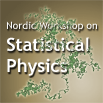Speaker
Tobias Ambjörnsson
(Lund University)
Description
The new melting map approach developed in our collaborator Jonas
Tegenfeldt's lab at Gothenburg University constitutes a
promising
ultra-fast alternative to previous DNA sequencing
techniques. Fluorescently
stained DNA is stretched in nanochannels and subsequently
heated. The
resulting local melting will reduce the quantum yield of an
intercalating
fluorescent dye such that black spots will occur along the
DNA. Since AT and
GC basepairs have different melting propensities the result
is essentially a
"barcode" that is a function of the sequence of the DNA and
that can thus be
used to identify the DNA from different organisms.
In this talk issues related to theoretical DNA melting calculations will be discussed. The Poland-Scheraga (PS) model of DNA melting has been proven to well reproduce (macroscopic) melting data. The PS model is an Ising model with a long-range term, expressed in terms of a critical random walk exponent c, due to the entropy associated with the melted single-stranded regions. The solution to two new problems in the DNA melting field will be addressed in the talk:
1) The numerical solution of the PS model is computationally prohibitive for bacterial genomes with 107 basepairs of interest in experiments. We therefore recently developed a coarse-grained approximate scheme for performing DNA melting calculations for heterogeneous DNA sequences, as a function of local fraction of AT and GC basepairs.
2) The problem of DNA melting for infinite homogeneous DNA sequences has been solved previously. In the talk finite-size effects in homoDNA melting will be discussed.
In this talk issues related to theoretical DNA melting calculations will be discussed. The Poland-Scheraga (PS) model of DNA melting has been proven to well reproduce (macroscopic) melting data. The PS model is an Ising model with a long-range term, expressed in terms of a critical random walk exponent c, due to the entropy associated with the melted single-stranded regions. The solution to two new problems in the DNA melting field will be addressed in the talk:
1) The numerical solution of the PS model is computationally prohibitive for bacterial genomes with 107 basepairs of interest in experiments. We therefore recently developed a coarse-grained approximate scheme for performing DNA melting calculations for heterogeneous DNA sequences, as a function of local fraction of AT and GC basepairs.
2) The problem of DNA melting for infinite homogeneous DNA sequences has been solved previously. In the talk finite-size effects in homoDNA melting will be discussed.

